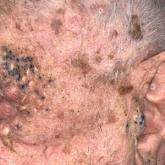Article

Periorbital and Tragal Cutaneous Lesions
- Author:
- Alexander Mounts, DO, MA
- Kristopher M. Peters, DO
A 91-year-old White man with no personal or family history of skin cancer presented to the dermatology clinic for a total-body skin examination. A...
